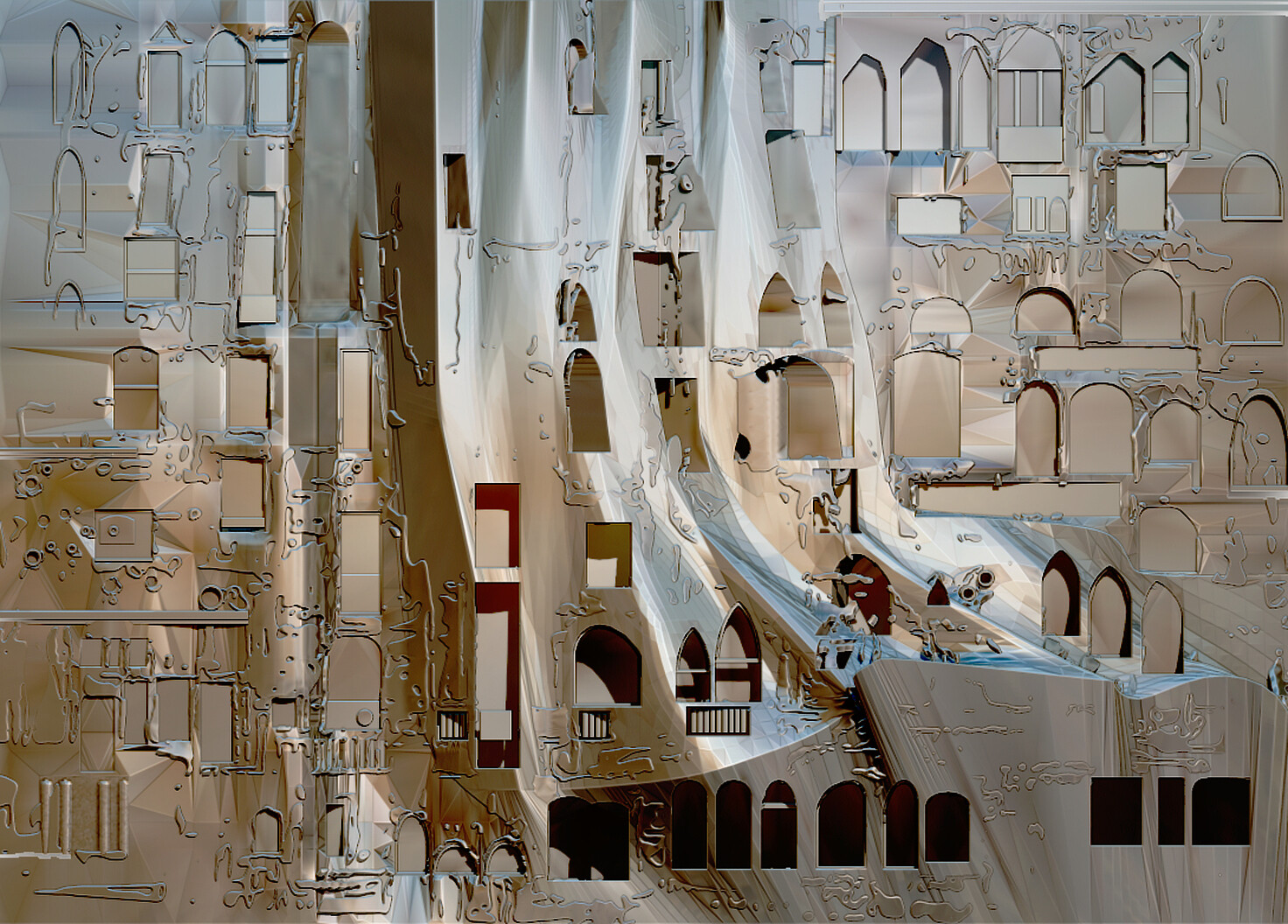A shining city on a hill
Cities of dreams have a long history. Utopia as a literary form dating from the reign of King Henry VIII is more than the articulation of a dream of ideal urbanism. Rather, it is a particular and specific style of political writing. Thomas More’s Utopia and other early examples of the genre were detailed colonial catalogues, a sort of political theory by way of natural history. Our narrator would be led round Utopia (always far away or impossibly isolated by geography or time) by a guide, immensely patient and knowledgeable, happy to answer all questions no matter how prurient or minute. Utopian literature is a taxonometric exercise that, through its interpolation in narrative, transcends the form of the blueprint or social reform tract. The narrative dreams of Utopian literature, at once hallucinogenically and mundanely detailed in the all-hungry-eyes manner of a frontier report to empire, are more than a blueprint for a new urban environment. They are an exercise in the intentional shaping of desire and political possibility.
Some groups have taken the Utopian urge further. During the Second Great Awakening, a period of intense religious revivalism during the early nineteenth century, dozens of splinter sects in the United States struck off on their own to found idealized urban communities with names like New Harmony, Prosperity, Economy, New Jerusalem, and Oneida. These intentional communities were often designed autocratically by charismatic religious leaders to approximate as closely as possible the ideal state of man or the Kingdom of Heaven come to earth, sometimes with the goal of inducing the Millennium through the perfection of their designs. They experimented with architecture and street plans, economic models, concepts of labor, property, relations between the genders, family planning, and child rearing. These practical experiments in urbanized spirituality were often short-lived, lasting only a few years before the stress of the idealized life fractured the community or the fervor burned away. Others, like the Mormons, the Oneida Community, or even the Shakers, lasted far longer, evolving and transforming over decades.
The promotional materials produced by corporate smart city projects serve the same guiding function as fictional utopian narratives and the idealized plans of the religious separatist. Smart city proposals position themselves tantalizingly close to the everyday, practically at the end of the nearest subway line. While the literary utopias of Thomas More, William Morris, Edward Bellamy, and the Utopian Socialists like Charles Fourier were inspirational dreams, the videos, prospectuses, and “vision documents” produced by Sidewalk Labs, Cisco, and IBM are conditional promises. They are half of a deal, a scrap of a warranty. Throw in with us, they say, and all this can be yours.
More’s Utopia begins with a pun. Utopia is a coinage, meaning either “The Good Place” (eutopia) or “No Place” or “No Where” (outopia). It’s a joke, right there at the front, about the irreconcilable and inseparable desirability and impossibility of the Utopian project. But how the dream is spun, how the promise is made, tells us a lot about the politics being sold. This is useful in modern smart city projects that often claim to be apolitical, as is the current fashion among the high-tech companies that design, promote, and sometimes build them. What politics do these projects deploy? In what direction do these proposals push the future of cities and the future of urban technology? How are their dreams already directing the conversation, dead-ending other avenues of development and design in swamps of detail?
In describing the utility of political utopias that were never intended to be built, Lewis Mumford wrote, “No Where may be an imaginary country, but News from No Where is still news.” Someone’s visions of the future always tell you at least as much about how they view the present and the past. What news, then, does Sidewalk’s latest dream of urbanism brings us from the No Where on Toronto’s Waterfront?
In the image of
The Sidewalk Toronto project has produced a lot of material, almost all of it digital. The high profile project is the first major undertaking of Sidewalk Labs, the New York City-based, smart city-focused sister company to Google under the Alphabet corporate umbrella. In addition to the 200-odd page “vision document” released when the deal was originally announced in October of 2017, there are videos, press releases, blog posts, white papers, artistic and architectural renderings, photos from public events, and reports stacked on reports of Sidewalk’s technological innovations and public engagement exercises. The Sidewalk Toronto website contains an overwhelming cascade of documentation.
307 Lake Shore Boulevard, currently the only physical manifestation of Sidewalk’s dream, is a combined exhibition/office/community space, showcasing digitally-composed architectural renderings, engineering models, explanatory exhibits, videos, and public input in the form of a wall of sticky notes. The Sidewalk Toronto newsletter announced in December that visitors would soon be able to explore potential housing units through a bespoke “VR experience.”1 The space has exhibited a set of fantastical models of city blocks designed and constructed by school children. The yard outside features a modular urban garden constructed out of black plastic milk crates, as well as seating, a collection of picnic tables, and a set of shipping containers that occasionally host local food vendors from Toronto neighborhoods. Every few weeks, Sidewalk Toronto throws an event in the space, a public lecture, an exhibition, or one of a series of planned “Public Roundtables,” which have been billed as events where members of the public can help Sidewalk “refine our thinking during key phases in the creation of the development plan.”2 There has been a kids camp; there are design jams; there are Sidewalk Fellows; there are Sidewalk grants for academics and artists interested in making the “future of cities” more “livable” and “sustainable.”
Still, though, the most solid manifestation of the Sidewalk Toronto dreamscape are the illustrations that accompany every new step forward (or sideways or backward). Sidewalk Toronto is, still, a digitally-bounded project, built out of renderings with persuasive power but no planning utility. Lush, colorful, calming, and detailed to a fantastic degree, these illustrations are a major component of the Sidewalk sales pitch.
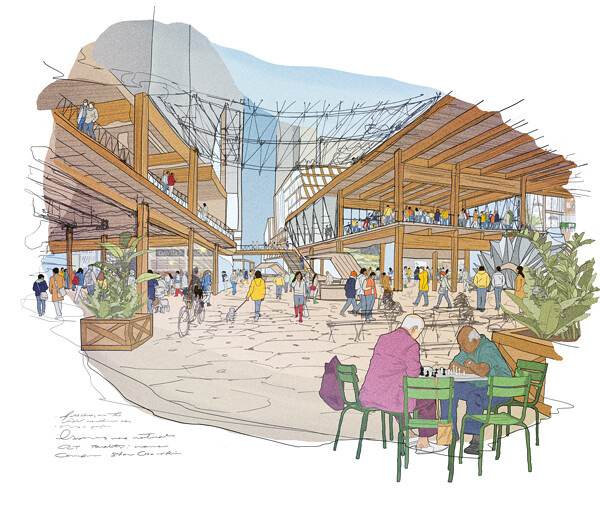

Andrew Edwards (Sidewalk Labs), Laneway, 2018. Source: Sidewalk Toronto.
Visual representations of utopia, either in actual pictures or via the drunk-with-description, vaguely colonial travelogue narratives that have marked the genre since Thomas More, have been a central aspect of Utopia’s powers of persuasion, inspiration, and political influence. Italo Calvino, author of the jewelbox atlas Invisible Cities, called Utopias “speaking pictures.” For Calvino, seeing an alternative world, flourishing, functioning, in images or in text, was essential if the public was to effectively imagine a better world than the one they saw every day. For even though many fictional Utopias are denuded of politics, the act of crafting a Utopian society is a profoundly and intentionally political act. A smart city utopia like Sidewalk’s Toronto project may be set in Genevieve Bell and Paul Dourish’s “proximate future,” always just out of reach but on our way, just a few steps further down the road.3 But to “discover the future,” as Fontaine Belford put it, to draw it out before an audience with affection and care and conviction, is “never disinterested.”4
The visual style of Sidewalk Toronto’s gallery of images has been remarkably consistent. The original “Vision Document” was ornamented with charming scribbly doodles of Toronto landmarks, cultural touchstones, and Torontonian in-jokes, including a greasy box labeled “poutine,” a funny jumble of faces and bodies representing the busy Bay and Adelaide intersection, and a “seagull (plump).” The architectural renderings in the document, and those released since, similarly had a cohesive, hand drawn, watercolor feel to them. The images are reminiscent of the complex cutaways in children’s books like David McCaulay’s The Way Things Work or Stephen Biesty’s Incredible Cross Sections. The people, drawn in ghostly white outline are too small to hold any detail, and they are enfolded into their environment in an implied whir of activity, giving the place an odd but cheerful haunted feeling. The buildings are mixed use, featuring residential apartments sharing structures with rock climbing gyms, offices, shops, art installations, and what looks like a giant still or kiln in one image. Green space and trees abound, and small suspended transit pods zip between buildings. In one image, a red construction crane is positioned at the center of the visual field, hoisting a modular apartment unit in to place over the quiet bustle on the streets below.
Drawn by Andrew Edwards, these renderings of Sidewalk Lab’s dreams for the Toronto Waterfront have been featured in almost every story written about the project. At the last public roundtable at 307 Lake Shore Boulevard in July, I asked Karim Kalifa, the director of Buildings Innovation for Sidewalk Labs, who the author was behind the images that have become synonymous with the public’s understanding of the project. Kalifa praised the work of “Andy,” an “intern” from Heatherwick Studio, Thomas Heatherwick’s design and architecture firm, which has previously worked with Sidewalk Labs founder Dan Doctoroff on his flagship Hudson Yards redevelopment project in New York City. “I just tell him a story and he goes,” said Kalifa, who, just an hour before, had given a presentation on the adaptability of the buildings planned the Sidewalk Toronto site, illustrated almost entirely with Edwards’s work. When I reached out to Sidewalk Toronto to see if I could speak with “Andy” about his work, I was told he was not available. Attempts to contact Edwards directly were also unsuccessful.
Sidewalk released another set of Edwards’s plush imaginings at July’s roundtable, and an additional suite of birds-eye renderings ahead of the December roundtable. The most impressive was an all-seasons panorama, measuring four-and-a-half feet long and nearly one-and-a-half feet tall, placed on every table in the room so they could be examined closely by members of the public at the July meeting. They are warm, inviting images, showing diverse crowds enjoying mixed-use, tall timber buildings with immaculate landscaping in all seasons and all kinds of weather. The walls of the buildings are drawn transparent or translucent, the people outside strolling hand in hand, visiting an open-air library, talking on the phone, or enjoying a garden party blend seamlessly with those inside, exercising in one of the ubiquitous rock climbing gym, enjoying a pop-up indoor market, or working in a machine shop that flows uninterrupted into an open plan office space. The seasons flow into each other was well, indicating the all-weather suitability of the space. The autumnal section shows a hint of transition, with a row of A-frame braces being installed to support the building’s winter “raincoat,” a building innovation Sidewalk has repeatedly highlighted in their materials and presentations. But beyond that, the people and their busytown activities hardly change. The structures depicted in the panorama, and the people in them, have achieved a gently bustling equilibrium, predictably and attractively the same in all conditions, all year round.
Other images released in July, both as oversized glossy printouts at the roundtable and directly to members of the press, included illustrations of pro-social laneways, with open-air walkways, cyclists, old men playing chess, and a reimagined Queens Quay, with shops, pedestrians, ferns, and stepped seating taking the place of cars and traffic jams. A particularly stunning image took a sweeping view of what Sidewalk called “Silo Park,” a not-yet-formally-proposed green space encompassing the Parliament Slip waterway, which, until this image appeared, was broadly assumed would be filled in and converted into buildable land. Silo Park, in this image, contained aquatic recreation facilities, an open-air market, multiple performance spaces including one floating stage, a transit extension, numerous mature trees and plants (and a heron in the foreground, flying across the viewer’s field of vision), origami-like structures providing shade and shelter, and the Victory Soya Mills Silos, an industrial relic that marks the east border of the Sidewalk Toronto site, transformed from a grey concrete eyesore into a vibrant, charismatic film projection screen. Edwards here shows the Silos illuminated by an iconic image from Georges Méliès’s 1902 silent film Le Voyage Dans la Lune. The viewer is positioned quite close to an elderly couple, looking over the scene below through binoculars as if from a designated scenic overlook. Edwards has, through his drawings, rendered us all welcome tourists in this brief glimpse of the future.
The amassment of detail present in Sidewalk Toronto’s published images and visions echoes Roland Barthes’ observation regarding the defining role of detail in Utopia: “perhaps the imagination of detail is what specifically defines Utopia (opposed to political science); this would be logical, since detail is phantasmatic and thereby achieves the very pleasure of Desire.”5 Barthes’ phantasms combine sense perceptions, memories, ideas, and situated perceptions and worldviews. A particular image can be a cultural phantasm, drenched with ideological meaning when viewed from a particular standpoint or by a particular group of people, or may be meaningless if viewed absent that context or preconditioning. For Barthes, what renders something Utopian rather than narrativized or illustrated “political science” lies in the semiotic luxuriousness of the phantasmic details themselves.
The richness of detail present in the illustrations and prospectuses of Sidewalk Toronto, and corporate smart cities in general, is fantastic, fantastical, and phantasmatic. Pull on the thread of, say, autonomous subterranean garbage robots, and it unravels a worldview with certain notions about climate, weather, infrastructure construction, trash and waste, the visibility of things rendered undesirable, and the social value of manual and municipal labor. That the details cohere ideologically, that they resonate with each other across the plans and dreams of a given project, that you can crack open any aspect of the dreamland and reveal, fractally, an identifiable worldview in miniature, is what makes Utopia pleasurable. And, conversely, that lack of perfect resonance, of fractal interior replicability is what makes cities in the real world so delightfully, irritatingly messy.
Urban frictions, the encounters between mutually unintelligible or barely intelligible cultures and populations are what propel an urban environment and its cultures forward. Utopias are concieved of as frictionless ecosystems, which have achieved a type of idealized stasis. Similarly, the very concept of productive unintelligibility is antithetical to the smart city project, which rests its entire operating premise on the notion that all relevant aspects of life within a smart city can and should be intelligible to the systems that operate it.
Despite the nods to Torontonian culture present on the endpapers of the Vision Document, the phantasms of the illustrations produced by Edwards are not Torontonian or Canadian. It would be a deft act of artistic and ideological ventriloquism if they were. Like the majority of the Sidewalk Labs and Sidewalk Toronto staff, Edwards is based in New York and is not Canadian. Moreover, it’s not Edwards’s purpose to artistically interpret the modern Torontonian moment. His work is here to establish a visual rapport with the audience for the Sidewalk Toronto project: engaged Torontonians and Canadians, of course, but also, and perhaps more directly, the global technocratic elite that consider “citybuilding” to be the next step in their career trajectory.
Remember: the stated goal of the Sidewalk Toronto project is to develop, through the extractive data-labor of residents, smart cities technologies for export by Sidewalk and Alphabet. Edwards’s images are intended to sell the project to people outside of Toronto as much as they are intended to soothe Torontonians, to convince them of the value, utility, and excitement of this particular geo-technological frontier. In this way, Edwards’s work echoes the work of earlier colonial artists working in the nineteenth century who sought to sell a politically coherent, attractive, and inviting image of life at the frontier primarily to people who weren’t there but who might want to be. Cornelius Krieghoff’s paintings of the Quebec colonial frontier, for example, with repeating visual motifs and themes of happy imperial expansion and conquest, bear a striking resemblance to the rendering produced by Edwards, particularly in the harmonized politics at work in the images and the repeatition of features and figures to induce a steady sense of place.6
The project of both Edwards and Krieghoff is to define and nostalgize proximate potential (proximate either geographically or temporally) using artful invokations of phantasmic images that are intended for and accessible to an audience outside the geographic boundaries of the project proposed. Krieghoff’s many painted variants-on-a-theme of habitants spilling joyously out of taverns into the Quebec snow in company of barking dogs and amusing carriage horses were not for those French-Canadians settlers depicted, but were intended for city-dwellers in Canada, the United States, and Europe who took pride in imperial expansion, and who might be convinced to immigrate and drive the imperial project forward with their bodies. It’s not that the Canadian notes in Edwards’s images are off. But rather, Torontonians are not their only, or even primary audience. The phantasmatic space is already occupied by a different sets of values and political ideologies.
The values present in the Sidewalk documents and illustrations are unsurprising to anyone who has followed the incursions of the tech economy into the civil sphere over the past decade. Where the Christian utopianist Harmonist town of Economy, Pennsylvania, founded in 1824, used straight streets, evenly divided land plots, and centrally positioned community spaces to communicate and enforce religious and social tenets, the Sidewalk project highlights in its tracts and images innovation, optimization, efficiency, and the central role of data. Municipal labor is automated away. The frictions, tensions, and irregularities of the urban environment are replaced with (theoretically) smoothly interlocking systems of innovative equilibrium. And the role of the citizen is whittled down into that of a producer of data for invisible systems to crunch.
Sidewalk Labs has repeatedly insisted that the materials it has released are not plans per se. I take them at their word on this. Despite their detail, pages of technical specifications, and self-contained, self-reinforcing phantasmic nature, these are not planning documents. These are utopian dreams, giving the feel of a city-within-a-city, one which abides by a distinct collection of ideals of urbanity.
The rest of the city literally fades into the background. Edwards renders non-Sidewalk buildings as transparent, unfeatured blocks. This is most surprising in the Silo Park rendering. Waterfront redevelopment in Toronto is a fraught political affair with a long (long) history. The area surrounding the Sidewalk Toronto site is currently undergoing a development boom, organized by Waterfront Toronto, the government-funded urban development corporation that initially brought Sidewalk Labs into this deal. Losing public access lakefront views to high-rise condos is politically unpopular in Toronto, but looking at the Silo Park picture, you’d never even know these developments were there. They’ve faded into ghostly insignificance, affording the Sidewalk site impossibly uninterrupted views of the lake.
Part of Sidewalk’s project is, as any Utopia project, what utopian scholar Ruth Levitas called “the education of desire.”7 Sidewalk’s materials introduce attractively framed options and foreclose potential alternatives. By presenting depictions of complete-unto-themselves urban systems and, as Kalifa told me, literal illustrations of a story of a near future of urbanity, Sidewalk argues its case at the level of projected, promised, densely described experience. Like other architectural models, these are sales documents. They invite the viewer to imagine themselves at home in a particular version of the future, in the narratives of the details. The political values at the core of Sidewalk’s re-vision of urbanity are presented indirectly, through Edwards’s images, played out through pictures of a new way of life. Just as utopianists and religious separatists imagined that a more perfect society could result in more perfect people, Sidewalk’s invitation is to imagine yourself as a product of their future. What kind of life could you have, what kind of person could you be, in Sidewalk’s city?
These are materials of persuasion, not collaboration. Everything is imagined for the audience, down the layouts of the microapartments. Again, it’s not that these are plans: it’s the completeness of the envisioning. There’s no imaginative work left to be done by the audience. All that is left is to project yourself in among the plants and the tall timber buildings and the all-season promenades and say yes.
Thanks, I hate it
There is, hanging around everything Sidewalk has done in Toronto, the cloying scent of The Gift. Gifts, as Marcel Mauss describes them, are not free, but are reciprocal tools of relationship construction, definition, and maintenance.8 Sidewalk has presented its plan as something it is bringing to Toronto to make Toronto better, more successful, better able to take its place and compete on a global stage. When the deal was first announced, Waterfront Toronto was positioned out front. Waterfront had chosen Sidewalk Labs for this project, Waterfront had crafted the CFP and invited Sidewalk to collaborate with them in their decades-long mission to rehabilitate Toronto’s long under-developed waterfront properties. Shortly thereafter, however, this narrative shifted. Suddenly, Sidewalk executives, include Dan Doctoroff, were talking about how Sidewalk had chosen Toronto as the site of its new innovative experiment in city building. The project was no longer framed as a technology-oriented development deal. In fact, most references to property development or land being sold were quickly walked back. This was about the future: of Toronto, of urban technology, of the idea of the City itself. Sidewalk Labs began promoting a narrative that had Sidewalk choosing Toronto because of its specialness, its place in what Doctoroff called “an elite class of cities in North America,” along with Sidewalk’s dual hometowns of San Francisco and New York City.
This shift in the origin story has allowed Sidewalk to promote a narrative of almost selfless generosity regarding the Toronto project. Sidewalk just wants to help Toronto reach its full potential as a hub of technology, business, and culture. A point continually made is that this project will generate jobs and new innovative businesses, making Toronto the center of a new global sector in smart city technology, all without costing the city a penny. This last point is debatable, considering that the value of the twelve-acre Sidewalk plot was recently estimated at $675 million dollars, and it continues to be unclear what Sidewalk’s intentions are for land development or data use. Other tempting promises, such as a pledge to move “Canada’s Google headquarters” to the site have under scrutiny devolved into commitments to “facilitate” shifting Google’s current Toronto office from one part of downtown to another.9
To refuse a gift is a complicated, often combative move. It creates offense, drawing a barrier between the giver and receiver that must now be acknowledged and defended. Torontonians have been reasonably trepidatious about the multinational American tech corporation knocking on their door, promising riches, and asking to be let in. But questions about the project, its business model, and its planned use of data have been treated almost as insults. A public roundtable Q+A was characterized by a Washington Post columnist as containing a “tone of defensiveness, if not annoyance” on the part of Sidewalk representatives responding to data privacy concerns.10 Micah Lasher, Sidewalk’s head of Policy and Communications, has gotten into what can charitably be described as Twitter spats with prominent local critics Bianca Wylie and John Lorinc.11 Wylie has further said that Lasher publicly characterized her critiques regarding data sovereignty and privacy as “disingenuous” and “motivated by personal gain.”12 Questions about a project that positions itself as a revolutionary innovation in the nature of urban life seem to be regarded as looking a gift horse in the mouth and rudely judging it wanting.
I interviewed Micah Lasher in February of 2018 for an article I wrote on the Sidewalk Toronto project for The Atlantic. When I asked him in February about the ideas put forward in the Vision Document, I was sharply chastised for, it seemed, reading the document carefully, taking it seriously, and considering its implications. Questions about the detailed descriptions of micro-apartments included in the Vision Document, and what that might mean for the potential residents of the neighborhood, led Lasher to accuse me of making things up, which seemed strangely defensive. He called the Vision Document a “snapshot in time” which shouldn’t be taken seriously as planning materials, but the ideas present there, along with the images crafted by Edwards, have reappeared time and time again over the past year with little change.
All of this is coming to a head at a moment when Toronto, as a city, is embroiled in an existential battle with the province of Ontario for basic rights of self-determination. To sum up a complicated political fight: Toronto has a population of 2.7 million, nearly 8% percent of the total population of Canada, and 20% percent of the total population of Ontario. (By comparison, New York City, counting all five boroughs, has a population of 8.6 million, roughly 2.5% of the total population of the United States.) In what can be described as an impressive fit of fraternal pique, Doug Ford, the recently elected Ontario premiere, head of the Conservative party, and brother of disgraced-now-dead former Toronto mayor Rob Ford, announced in the middle of Toronto’s 2018 municipal elections his intentions to unilaterally halve the number of Toronto city councilors from the newly-expanded forty-seven members, or one for approximately every 58,118 people, to twenty-five, or one for every 109,262 people. The move realigns the city’s municipal electoral ward boundaries with its provincial and federal ward boundaries. Sold as a way to cut costs and municipal gridlock, what it amounts to is a disenfranchisement campaign waged by the Province of Ontario against its most populous urban center.
The city of Toronto’s twenty-five representatives in both the Legislative Assembly of Ontario and the Federal House of Commons each represent an average of 109,262 people. For comparison, the Maritimes province of Prince Edward Island, where Anne of Green Gables is set, has four parliamentarians in the House of Commons. They each represent 36,464 people. Each member of Prince Edward Island’s twenty-seven-member provincial legislature represents about 5,500 people. There are 145,855 people on Prince Edward Island, which, again, is only 40,000 more than the population that each Toronto city councillor represent under Ford’s new ward map. Ford is further moving to have certain city functions “uploaded” to the province, probably as a precursor to privatization, meaning Toronto could lose control of its public transit system, among other civic services and public utilities like power generation.
This is not the first time the province, under a Conservative premiere, has forced fundamental changes onto Toronto, changing its political and civic nature. In 1998, the provincial government of Ontario, led by Progressive Conservative premier Mike Harris, unilaterally dissolved the municipal borders between the then City of Toronto and its five neighboring municipalities, York, East York, North York, Etobicoke, and Scarborough, to create the modern “megacity” of Toronto. Unamalgamated Toronto voted down a referendum on the issue by a margin of three to one. But the province was not and is not beholden to the results of city referenda, and so the City then became the City now, with the primary impact of diluting the Liberal voting base of the downtown core.
Though this battle over municipal representation within the city’s borders began after the Sidewalk deal was inked, it is deeply ironic, and hilarious apt, that Sidewalk Labs should be proposing to build its technocratic City of the Future in a place that has remarkably little power over itself as a city.
The Sidewalk Toronto project is currently being examined as a bellwether for what future smart cities could be. But Toronto itself should be considered a harbinger of the choices already existing cities will have to make in the near future. Though the Toronto case is extreme, it is far from alone regarding the relative lack of power major urban areas have over their own future. As we saw in the last US presidential election, due to the Constitutionally-mandated two electoral college votes every state receives, plus a number based on population as determined by the last ten-year census, each elector from, say, the rural state of Wyoming represented 194,666 people while New York’s twenty-nine electors each represented 684,482 people, more than triple the number. Each of California’s fifty-five electors each represent 718,909 people. Legislatively, voters in major US cities face a similar crisis of representation. New York City’s 8.5 million people are represented by sixteen Congressional districts, which represent an average of over half a million people each. The disenfranchisement of Toronto is the same disenfranchisement faced by cities across North America.
In Toronto’s 2018 municipal election, one of the major mayoral candidates openly considered seceding Toronto from the province of Ontario.13 Radical departures from the norm of neoliberal capital are being proposed. But it still seems there are only two likely choices for the city’s future: accept the gift of the Americans and betroth the city to a multinational corporation that wants to try its luck at establishing a colonial experiment in algorithmic utopian citybuilding, or continue its long draining squabble with a provincial government that harbors an active personal animus towards the idea of cities in general and the fact of Toronto in particular.
As political documents, Utopias have always been about societies of cities. They have also always been about intentional unreachability. Behind a mountain, on an island, or tucked away in the future, the practical inaccessibility of the phantasmic utopia has provided an excuse for why it will never be practically achieved. It is also intended to inspire and forgive imperfect imitation. The imperfect nature of man has always covered for the failure to found an earthly City of God.
Sidewalk’s offer of the gift of its perfect city, perfect as long as you don’t fight it, in this way betrays the nature of both the project of utopia and the project of the modern democratic city. Utopias must be chosen and strived for, and the democratic city must similarly be an active labor of all who live there. Sidewalk Toronto is just another kind of “upload,” Toronto becoming a creature of Alphabet’s cloud instead of a creature of the province. The project has been presented as a break with existing urbanist practice, and as logically follows, with the existing realities of the city itself. As Doctoroff said in Sidewalk’s October 2017 announcement video, still the first thing you see on the Sidewalk Toronto website, in this project, “[w]e have an opportunity to fundamentally redefine what urban life can actually be.” Eric Schmidt, the longtime Google executive and former chairman of Alphabet, who resigned last December in order to devote more time to Sidewalk Labs, said a founding impetus of Sidewalk was the dream of “all the things we could do if someone would just give us a city and put us in charge.”
Their dream is clear. It may be true that cities in North America are slowly slouching towards a representational crisis, where having a proportional impact on the national communities they are embedded within is increasingly a mathematical impossibility. Sidewalk, and companies like it, suggest that handing over the reins to them is the best solution. Instead of a Toronto beset by a housing crisis, a revenue crisis, a representation crisis, and attacks from the province, we could have a Good Place, a generic No Place on the lake, whose purpose is clear, and it could all be as pretty as a picture.
“A housing unit for the 21st century. Plus, a Replica pilot.” Sidewalk Labs email newsletter (14 December 2019).
➝.
Genevieve Bell and Paul Dourish, “Yesterday’s Tomorrows: Notes on Ubiquitous Computing’s Dominant Vision,” Personal and Ubiquitous Computing vol. 11, 2 (January 2007).
Fontaine M. Belford, “Yesterday’s Dreams, Tomorrow’s Necessity,” Utopias: The American Experience, eds. Gairdner B. Moment and Otto F Kraushaar (Metuchen: The Scarecrow Press Ltd., 1980).
Emphasis original.
Ruth Levitas, The Concept of Utopia (Oxford: Peter Lang Ltd., 2010).
Marcel Mauss, The Gift: Forms and Functions of Exchange in Archaic Societies (New York: W. W. Norton & Company, 1978).
➝.
➝.
➝.
Full disclosure: I know Wylie personally and was present at the roundtable where this confrontation took place. I did not witness it but Wylie recounted to me what happened immediately afterwards, which I recorded in my field notes from the evening. ➝.
➝.
Becoming Digital is a collaboration between e-flux Architecture and Ellie Abrons, McLain Clutter, and Adam Fure of the Taubman College of Architecture and Urban Planning.









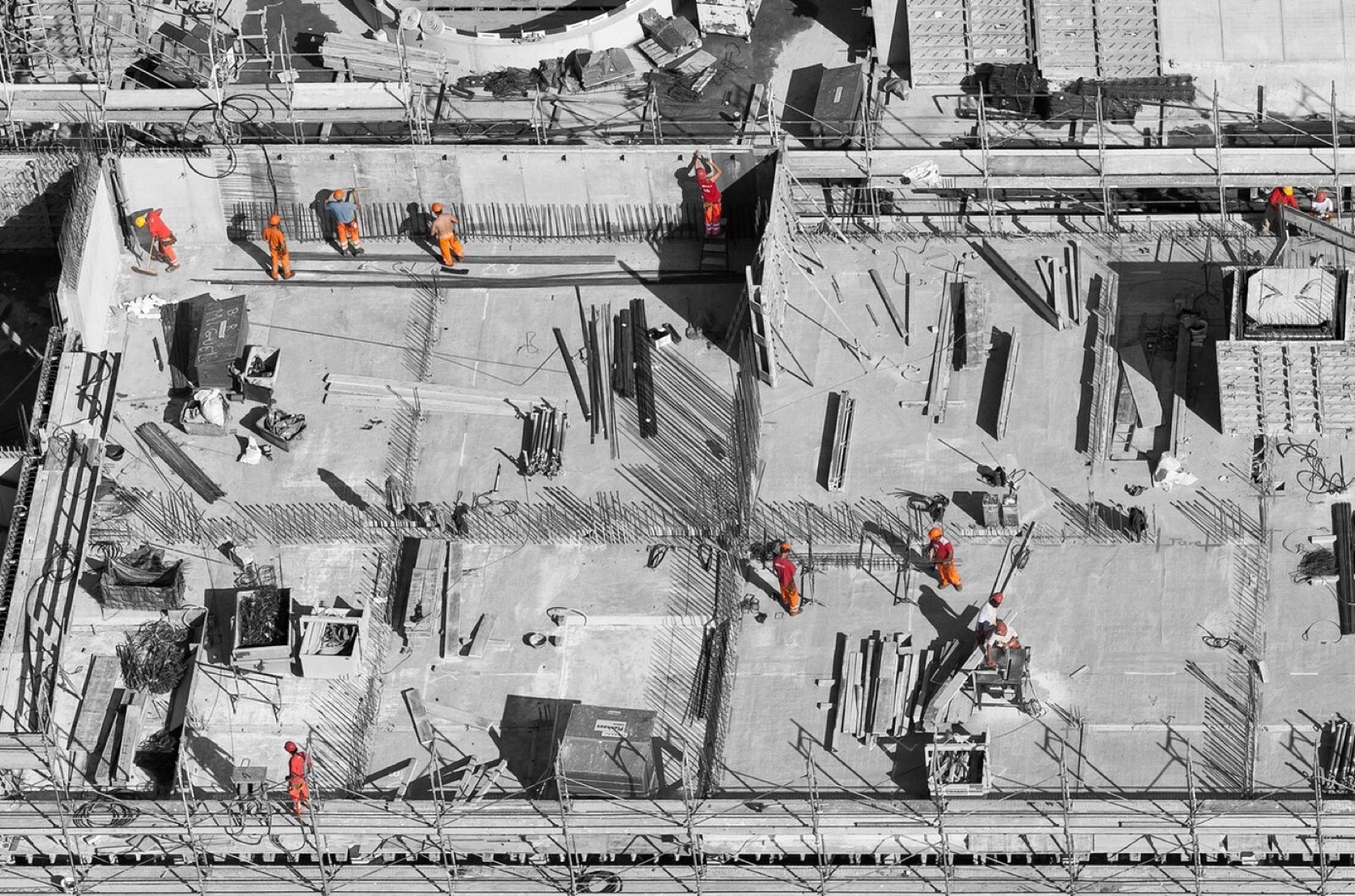
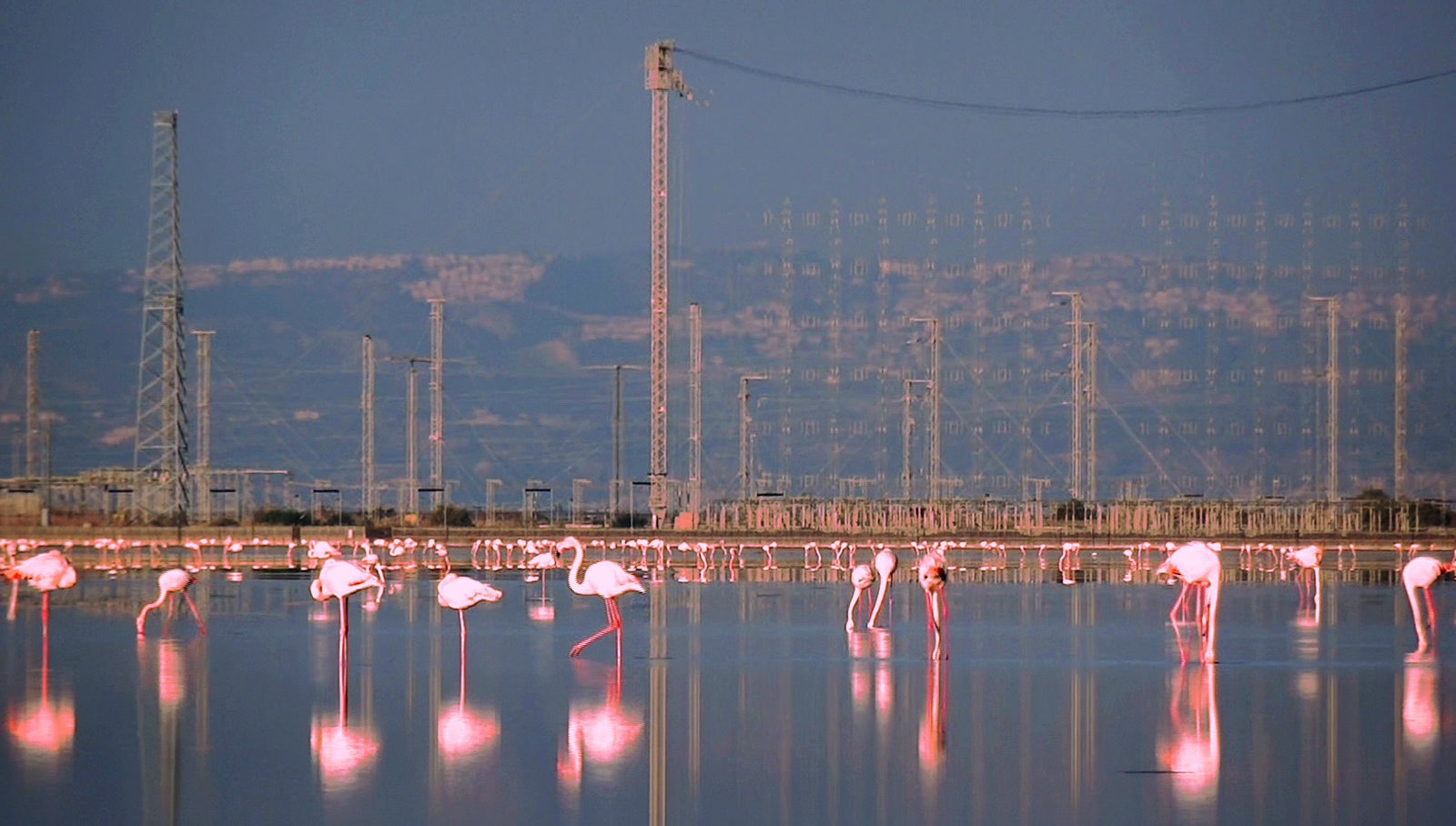
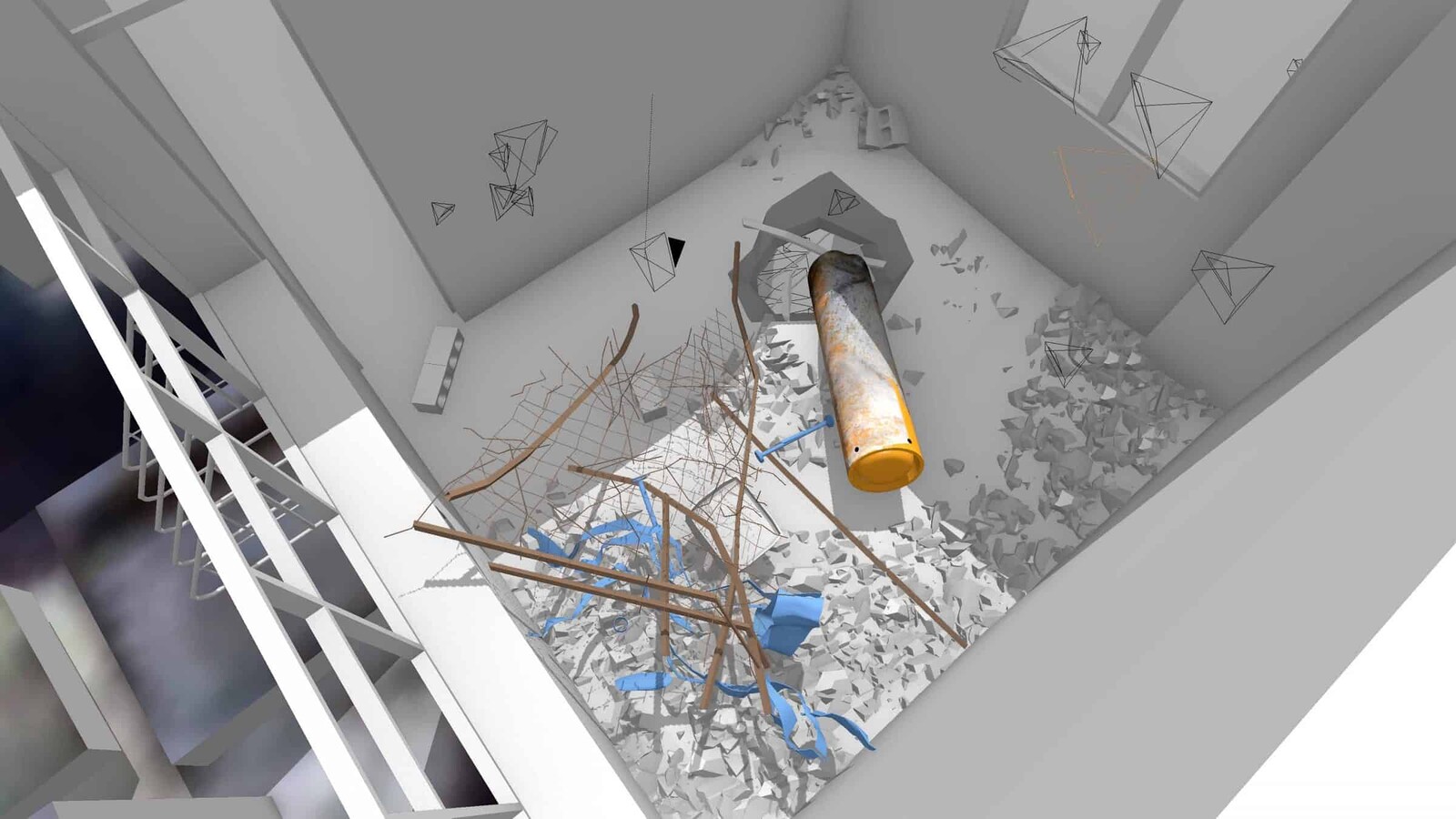


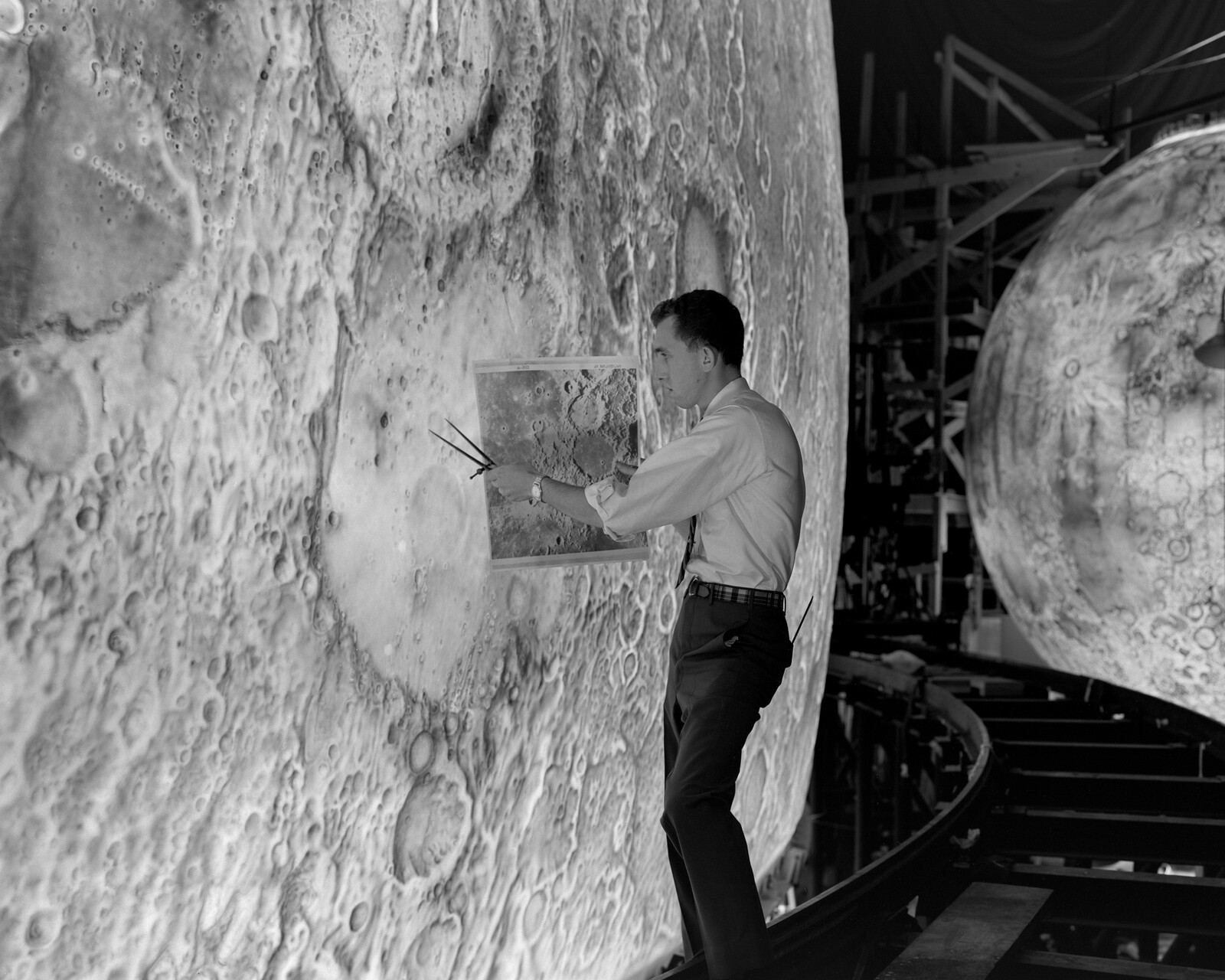
.jpg,1600)

